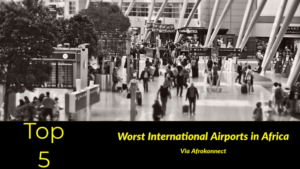
However, for travelers navigating through Africa’s diverse landscapes, the airport experience can be a critical factor in shaping their overall impression. While the continent boasts some outstanding airports, there are others that leave much to be desired. In this exploration of air travel, we will unveil the Top 5 Worst Airports in Africa, shedding light on the challenges faced by passengers in these less-than-ideal travel hubs.
From outdated facilities to operational inefficiencies, each airport on this list paints a vivid picture of the struggles faced by travelers in their quest for smooth and stress-free journeys across the African skies. Join us as we delve into the issues plaguing these airports and discuss the potential for improvement in the region’s aviation infrastructure.
Top 5 Worst International Airports in Africa
1. KINSHASA N’dJILI INTERNATIONAL AIRPORT, CONGO
Our first stop takes us to KINSHASA N’dJILI International Airport in the heart of the Congo. Despite its strategic location, It struggles with outdated infrastructure, poor facilities, and a lack of organization. Travelers often face endless queues, delayed flights, and minimal amenities, leaving them with a less-than-pleasant experience.
KINSHASA N’djili International Airport, located in the Democratic Republic of Congo, stands as a testament to the myriad challenges faced by travelers in the heart of Africa. As one of the busiest gateways to the region, this airport, also known as N’djili Airport, grapples with a host of issues that have earned it a spot on the list of the Top 5 Worst Airports in Africa.
Infrastructure Woes:
KINSHASA N’djili International Airport grapples with aging infrastructure, leading to significant operational challenges. Outdated terminals, lack of modern amenities, and inadequate facilities contribute to a subpar passenger experience. Travelers often find themselves navigating through congested spaces, exacerbating the stress of air travel.
Limited Connectivity:
Despite being a crucial hub for the region, KINSHASA N’djili International Airport faces challenges in maintaining efficient air connectivity. Limited direct flights, irregular schedules, and unreliable services have resulted in a cumbersome travel experience for passengers connecting through this airport.
As we explore the challenges faced by KINSHASA N’djili International Airport, it becomes evident that addressing these issues is crucial for enhancing the overall travel experience in the region. The journey towards transformation and modernization is essential, not only for the airport but also for the reputation of air travel within the Democratic Republic of Congo.
2. Maiduguri International Airport, NIGERIA
Next on our list is Maiduguri International Airport in Nigeria, a once-promising hub that now stands as a symbol of neglect. Broken escalators, outdated technology, and a general lack of maintenance have turned this airport into a shadow of its former self, leaving travelers stranded in an environment that seems frozen in time.
Since the Boko Haram Insurgency, the airport has struggled to recover and pick up from where it was before the insecurities. An airport that once handles international travels now seems to struggle with even domestic runnings.
Maiduguri International Airport, situated in the northeastern region of Nigeria, serves as a vital gateway to a region marked by resilience in the face of adversity. However, despite its strategic importance, the airport grapples with a set of challenges that impact both the local populace and travelers passing through. In this exploration, we shed light on the unique dynamics surrounding Maiduguri International Airport.
Security Concerns:
Maiduguri, being located in a region historically affected by insurgency, faces persistent security challenges. The airport has, at times, been subjected to security threats, leading to concerns among passengers and necessitating heightened security measures. The delicate balance between ensuring safety and providing a smooth travel experience poses an ongoing challenge for the airport authorities.
Weather-Related Challenges:
The northeastern region of Nigeria is prone to weather extremes, including harmattan dust haze and seasonal rains. These weather conditions can lead to flight disruptions and delays, affecting the reliability of services at Maiduguri International Airport. Addressing these weather-related challenges is crucial for establishing a more dependable and resilient air travel network.
Regional Development Impact:
Maiduguri International Airport’s challenges have broader implications for the economic and social development of the region. Limited air connectivity can hinder the flow of goods and people, impacting trade and tourism potential. Addressing these challenges is not only essential for improving the airport itself but also for fostering regional development and connectivity.
In the midst of these challenges, Maiduguri International Airport remains a symbol of resilience and determination. Efforts to address security concerns, enhance connectivity, and invest in modern infrastructure can contribute to unlocking the airport’s full potential, making it a key player in the economic and social development of northeastern Nigeria.
Worst International Airports in Africa
3. N’DJAMENA INTERNATIONAL AIRPORT, CHAD
Our third destination is the uniquely challenging N’DJAMENA INTERNATIONAL AIRPORT in Chad. Battling the unforgiving Harmattan winds and sandstorms, this airport frequently experiences disruptions in flight schedules and poses significant challenges for both passengers and airport staff.
Navigating through the sands, travelers find themselves in a constant struggle against nature. While it plays a pivotal role in facilitating air travel for the region, the airport is not without its set of challenges. In this exploration, we delve into the dynamics surrounding N’Djamena International Airport and the efforts being made to overcome its obstacles.
Limited Air Connectivity:
Despite being the capital city’s primary airport, N’Djamena International Airport faces limitations in terms of direct flights and air connectivity. This can result in inconvenience for passengers who may have to rely on indirect routes, impacting both local and international travel. Enhancing air connectivity is vital for positioning the airport as a more efficient and accessible transportation hub.
Security and Safety Considerations:
The geopolitical landscape in the region introduces security concerns that can affect operations at N’Djamena International Airport. The airport has had to navigate challenges related to security protocols and measures, striking a balance between ensuring passenger safety and maintaining a smooth travel experience. Addressing security concerns is paramount for the sustained growth and reputation of the airport.
Economic Implications:
N’Djamena International Airport plays a crucial role in facilitating trade and commerce in Central Africa. The challenges faced by the airport, such as limited connectivity and infrastructure constraints, have economic implications for the region. Fostering an environment that encourages international investment and trade requires strategic improvements in the airport’s capabilities.
As Chad continues to develop and integrate into the global economy, addressing the challenges faced by N’Djamena International Airport is crucial. With concerted efforts in infrastructure development, enhanced connectivity, and strategic collaborations, the airport has the potential to evolve into a more resilient and pivotal player in the aviation landscape of Central Africa.
4. KOTOKA INTERNATIONAL AIRPORT, GHANA
Moving on to Ghana, we arrive at KOTOKA International Airport. While the country boasts a rich cultural heritage, the airport struggles to keep up with the increasing passenger demands. Overcrowded terminals, insufficient seating, and frequent baggage mishandling incidents make this airport a less-than-ideal choice for those seeking a smooth travel experience.
Kotoka International Airport, located in the vibrant capital city of Accra, stands as a key aviation gateway for West Africa. Renowned for its strategic importance, the airport has undergone significant transformations in recent years to meet the growing demands of air travel.
Sustainable Practices:
In recent years, Kotoka International Airport has taken strides towards incorporating sustainable practices. Initiatives such as energy-efficient facilities and waste management programs demonstrate the airport’s commitment to environmental responsibility, contributing to the global push for greener aviation.
Economic Catalyst:
Kotoka International Airport plays a pivotal role in Ghana’s economic development by fostering international trade and tourism. The airport’s efficient operations and connectivity contribute to the country’s attractiveness for foreign investment, positioning it as an economic catalyst for the region.
As Kotoka International Airport continues to evolve, it sets a positive example for the aviation industry in West Africa. Through its commitment to modernization, connectivity, passenger services, technology, sustainability, and economic development, the airport stands as a symbol of Ghana’s aspirations to be a leading player in the global aviation landscape.
5. KHARTOUM AIRPORT, SUDAN – Worst International Airports in Africa
Our final destination brings us to KHARTOUM Airport in SUDAN, where the challenges extend beyond just outdated infrastructure. Security concerns loom large, and the overall desolation of the surroundings raises eyebrows. Travelers here often find themselves questioning the safety of their journey, adding an extra layer of discomfort to an already challenging travel experience.
Efforts are underway to enhance connectivity at Khartoum International Airport, fostering improved relations with airlines and expanding the range of destinations served. These initiatives aim to position the airport as a central node for air travel in the region, providing more convenient options for both domestic and international travelers.
Khartoum International Airport holds significant economic potential for Sudan. As the country seeks to attract foreign investment and boost trade, the airport’s role in facilitating business travel and cargo transportation becomes increasingly vital. Addressing challenges and enhancing operational efficiency will contribute to unlocking the economic potential embedded in the airport.
As Sudan strives for economic development and increased global engagement, addressing the challenges faced by Khartoum International Airport becomes integral. Through strategic investments in infrastructure, connectivity, economic development, and security measures, the airport can solidify its position as a key player in fostering Sudan’s connections with the world. The journey ahead involves not just overcoming challenges but also leveraging the airport’s potential to contribute to Sudan’s growth and development on the crossroads of Africa.
RECOMMENDED:
- Top 10 Poorest Countries in Africa – Latest Ranking
- 1O Countries to work Abroad for better career opportunities
- Weakest Currencies in Africa – Latest Ranking
Worst International Airports in Africa

Conclusion on Worst International Airports in Africa
In conclusion, the narratives surrounding Kotoka International Airport in Ghana, Khartoum International Airport in Sudan, N’Djamena International Airport in Chad, and Maiduguri International Airport in Nigeria paint a diverse picture of the challenges and triumphs faced by airports across the African continent. Each airport stands at a unique intersection, reflecting not only the complexities of modern air travel but also the broader socio-economic and geopolitical landscapes of their respective regions.
While Kotoka International Airport exemplifies the success of strategic investments, modernization, and sustainable practices in elevating air travel standards, Khartoum International Airport navigates the intricate tapestry of historical significance, diplomatic relations, and economic potential.
On the other hand, N’Djamena International Airport grapples with infrastructure limitations and security concerns in its pursuit of becoming a resilient regional hub, while Maiduguri International Airport in Nigeria strives for connectivity and resilience amidst security challenges.
These stories underscore the multifaceted nature of the aviation industry in Africa, where airports are not merely points of transit but integral players in shaping economic development, fostering regional connectivity, and serving as diplomatic gateways. As the continent continues to undergo transformations and the global aviation landscape evolves, the challenges faced by these airports also present opportunities for growth, collaboration, and innovation.
In addressing these challenges, be it through modernization efforts, enhanced connectivity, security measures, or economic initiatives, these airports stand as beacons of resilience. They signify the collective aspirations of their nations to integrate into the global community, drive economic prosperity, and provide seamless travel experiences for passengers.
In the grand tapestry of African aviation, each airport contributes its unique thread, weaving a story of challenges overcome, lessons learned, and potential realized. As the journey continues, the shared commitment to improvement and progress propels these airports forward, playing pivotal roles in shaping the narrative of air travel across the continent. The future beckons with the promise of more efficient, connected, and vibrant airports, reflecting the dynamism and determination of the African spirit.
As we conclude our journey through the Top Five Worst Airports in Africa, it’s evident that challenges such as outdated infrastructure, inadequate facilities, and environmental factors contribute to the struggles faced by both passengers and airport authorities.
While these airports may not represent the entirety of the African aviation landscape, they serve as a stark reminder of the improvements needed to make air travel across the continent a more seamless and enjoyable experience. Until next time, safe travels and may your skies be clear and welcoming. Thank you for reading and please do not forget to follow us on social media while you like and share this post.
















[…] complex world of travel and find the perfect travel agency in Lagos to suit your needs. Here are 5 Worst AIRPORTS in Africa to avoid by all […]